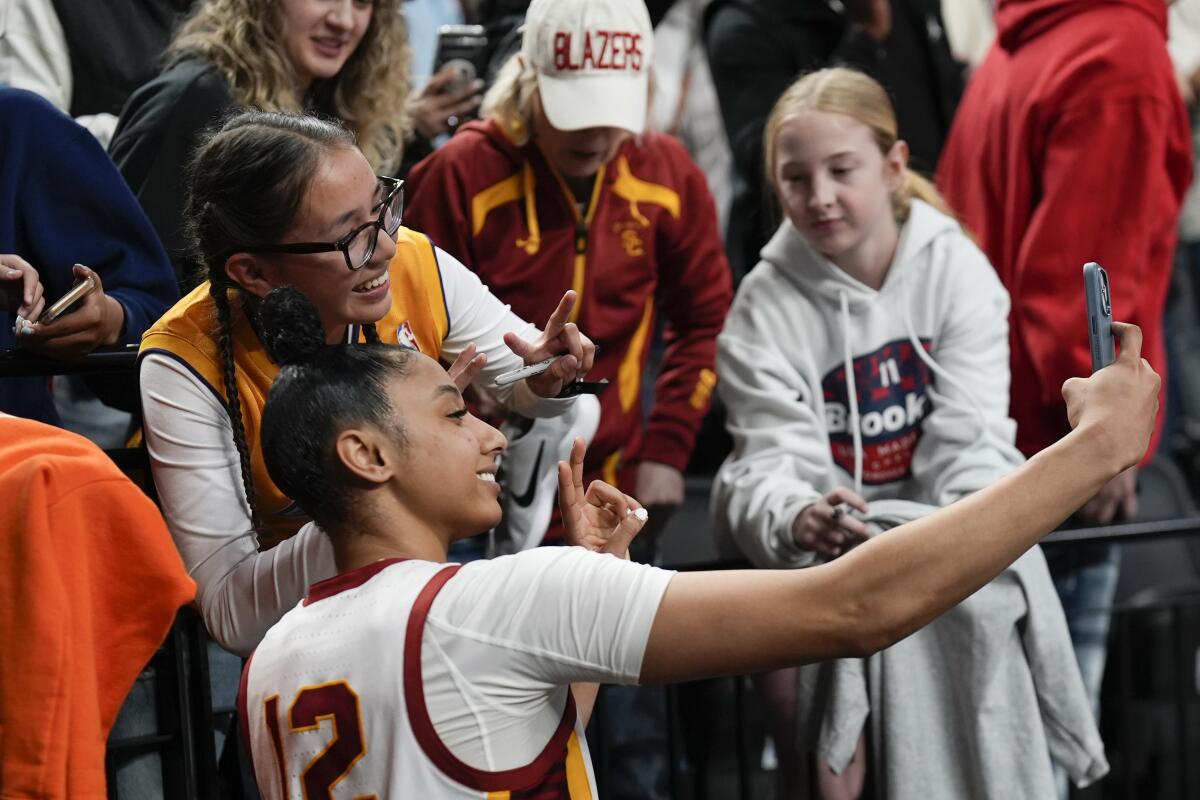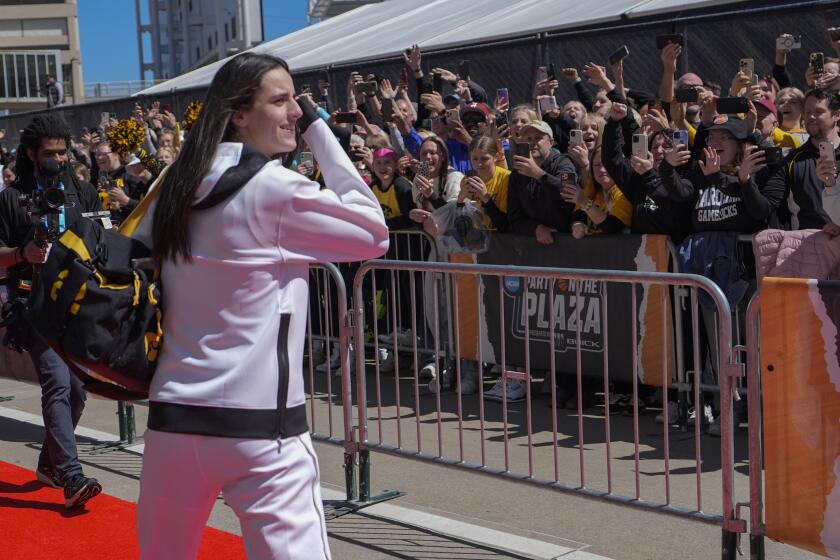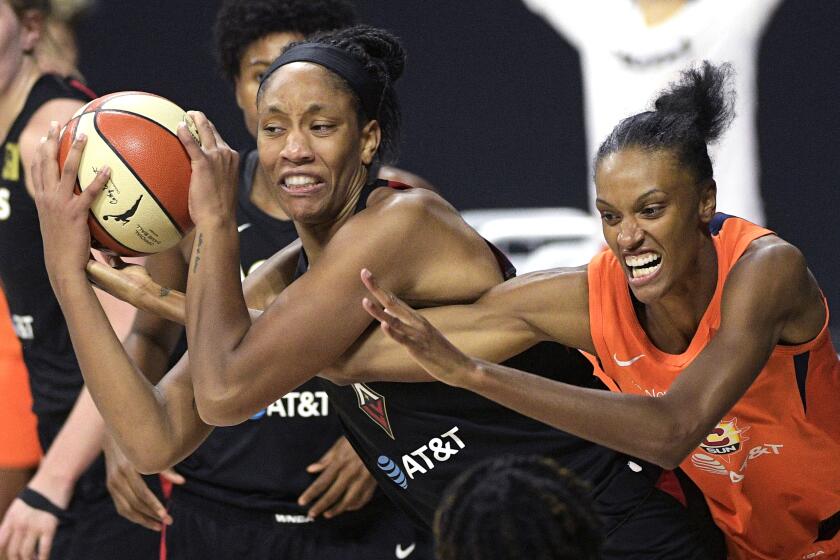Why can’t JuJu Watkins enter the WNBA draft early? And even if she could, should she?

- Share via
As JuJu Watkins wiped tears from her eyes with the corner of her jersey after USC’s season-ending loss to Connecticut in the NCAA regional final, UConn coach Geno Auriemma gave Watkins two encouraging pats on the back. He said a few words into the freshman’s ear.
What did the legendary coach tell USC’s heartbroken star who set the NCAA Division I freshman scoring record in the crushing defeat?
“Go pro,” Auriemma joked later.
But even with the legendary coach’s light-hearted encouragement, Watkins probably won’t hear her name called in the WNBA draft until 2027.
To be eligible for the draft, domestic players must turn 22 years old during the calendar year of the event or have graduated from a four-year university prior to, or within the three months after, the draft.
Caitlin Clark is expected to go No. 1 to the Indiana Fever in the WNBA draft, and fans will get to see the Iowa star a lot on TV. Indiana has the most national broadcasts.
The age requirement has been included in the league’s collective bargaining agreement since its first deal in 1999 with little challenge. But stars like Watkins are just the first in a wave of players advancing their games faster than ever. The shift in talent could force further examination of the WNBA’s rule.
“If these players are ready and they don’t want to be in school and they want to go pursue [the WNBA], I don’t see why you should hold them back,” said USC assistant coach Chris Koclanes, who spent the previous eight years working for the WNBA’s Connecticut Sun and the Sparks. “Give them the option.”
The current CBA runs through 2027, but players could opt out after the 2024 season to begin negotiations early and capitalize on rising attention around the league. Changes would take effect as early as the 2026 season. Watkins would be finishing her junior year at USC.
Allowing younger prospects was on the minds of players during collective bargaining in 2019, but with larger issues such as salaries, travel and family planning benefits, “we just couldn’t get to it,” former Seattle Storm star Sue Bird said on ESPN during the NCAA women’s national championship game.
“What happens in those negotiations is you have like 20 things you want to change,” said Bird, the former vice president of the WNBA players association. “If you get to three, it is magic.”
The reigning national freshman of the year who set USC’s single-season scoring record isn’t the first to spur this conversation. Even as freshmen, Caitlin Clark and Paige Bueckers were earning raves as potential WNBA contributors. If they were eligible in the 2021 draft, when Texas forward Charli Collier went first overall, they would have been the top two college prospects, Phoenix Mercury star Diana Taurasi told ESPN at the time.
The WNBA broke records for viewership during the season. Will these numbers be what the league needs to turn the corner on financial growth?
Three years later, Clark is poised to go first overall to the Indiana Fever in Monday’s draft.
Clark’s draft moment, no matter how delayed, exemplifies the advantages of the age requirement. Division I basketball’s leading scorer enters the WNBA ready to make an immediate impact on the court, and she carries a legion of fans with her. The result is unprecedented attention for a league looking for its next marketable star.

“There’s a real advantage that we’re seeing with the women’s game,” former WNBA president Donna Orender said. “Collegiately, athletes staying together on teams, the quality of those teams, consistency, their fan base, their own brands as opposed to popping out young.”
Even if the age requirement suddenly shifted, it’s still unlikely players would leave early. They would be giving up the security of college for a league where more than half of every draft class struggles to even make a season-opening roster. Many elite college programs, including UCLA and USC, already travel on chartered flights. Players have round-the-clock access to first-class training facilities with their schools.
In 2009, guard Epiphanny Prince left Rutgers after her junior season to sign a professional contract in Europe, but with name, image and likeness rules implemented recently, players don’t have to choose earning potential over eligibility anymore. Matching the equivalent of a lottery pick’s rookie salary of $68,000 is not only possible, it’s easily attainable for a phenom such as Watkins — whose reported six-figure NIL valuation already eclipses the 2023 average WNBA salary of roughly $113,000.
But what puts Watkins at the center of the draft eligibility conversation isn’t just that she’s poised to be the sport’s next commercial star. It’s that she has the game to back it up.
Koclanes, who helped coach the Sun to the WNBA Finals in 2019 and 2022, says he believes the 6-foot-2 teenager already has the skill set, strength and mindset to play in the league.
“If I’m being completely honest, I think she could come off the bench and be a spark plug for somebody right now,” Koclanes said. “She would have to adapt because from high school to college, now college to the pro, it’s a whole other level of speed, physicality. But the way she’s been able to adjust already here, she’s going to be able to do it.”
The WNBA is often unforgiving for rookies as rosters are not only shorter than their 15-player NBA counterparts, but WNBA teams don’t have two-way contracts or a developmental league.
The Sparks have finalized the roster for the 2023 season that includes familiar and new faces, but players are calling for roster expansion.
Players have tried to approach the WNBA about roster expansion or loosening the hard salary cap that often limits teams to 11 players, but the solution was “not lucrative,” WNBPA president Nneka Ogwumike said last year.
The issue could come up again during the next round of negotiations. Players are also expected to call for charter flights, revisions to the prioritization clause that limits overseas opportunities and better revenue sharing. Each topic could easily overshadow potential revisions to the age requirement.
But each area still contributes to the overall growth of women’s basketball, Orender emphasized. The cumulative effect leads to the possibility that the next generational talent could one day not only choose to play with the pros early, but also receive top-notch treatment and development opportunities on the other side.
“It’s a real indicator of growth and interest that the WNBA is a destination for the best talent in the world and that young players are targeting it,” Orender said. “That’s where they want to be. That’s where their goals are in addition to winning a national championship.”
More to Read
Fight on! Are you a true Trojans fan?
Get our Times of Troy newsletter for USC insights, news and much more.
You may occasionally receive promotional content from the Los Angeles Times.










